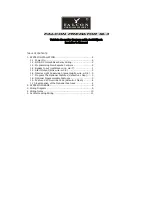
5
Installation and commissioning
Indoor Sensor KNX AQS/TH
• Date of issue: 13.10.2011 • Subject to technical changes. Errors excepted.
* Please consider the notes on Accuracy of the measurement, Seite 5
The following standards have been considered for the evaluation of the product in
terms of electro magnetic compatibility:
•
EN 50090-2-2: 1996/A2:2007
•
EN 61000-6-1: 2007
•
EN 61000-6-3: 2007
The product has been tested for the above mentioned standards by an accredited EMV
laboratory.
1.1.1. Accuracy of the measurement
Measurement variations from sources of interference (see chapter
Installation positi-
on
) must be corrected in the ETS in order to ensure the specified accuracy of the sensor
(offset). To ensure a correct CO
2
measurement, the device must be installed in a wind-
proof socket.
The indiceted accuracy of the CO
2
measurement will be achieved after a run-in period
of 24 hours (without interruption of the bus voltage) if the sensor has been in contact
with fresh air (350…450 ppm) at least once in this period.
After this, the CO
2
sensor will recalibrate every two weeks by defining the lowest mea-
sured value captured during that period (without interruption of the bus voltage) as a
reference for fresh air.
The guarantee the accuracy on a sustained basis, the sensor should be provided with
fresh air at least once in two weeks. This occurs normally during room ventilation.
2. Installation and commissioning
2.1. Notes on installation
Installation, inspection, commissioning and troubleshooting of
the device must only be carried out by a competent electrician.
Disconnect all lines to be assembled, and take safety precautions against accidental
switch-on.
The device is exclusively intended for appropriate use. With each inappropriate change
or non-observance of the instructions for use, any warranty or guarantee claim will be
void.
After unpacking the device, check immediately for any mechanical damages. In case of
transport damage, this must immediately notified to the supplier.
If damaged, the device must not be put into operation.
If an operation without risk may supposedly not be guaranteed, the device must be put
out of operation and be secured against accidental operation.







































